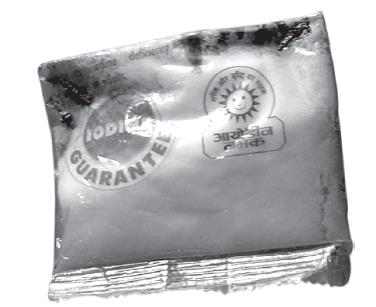
What are the levels of iodine in the iodized salt at the production and the consumption level?
• At the production level—Not less than 30 ppm (parts per million)
• At the consumption level—Not less than 15 ppm
Name the regulation under which these levels are fixed.
The Food Safety and Standards Act, 2006
Why salt is used as a medium for iodization?
• Salt is universally consumed by almost all sections of a community irrespective of economic level.
• It is consumed at approximately the same level throughout the year in a given region by all normal adults, thereby facilitating uniform dosage throughout the year.
• The production of salt is generally limited to a few centers, unlike other food commodities. By iodization of salt at these locations, a majority of the population will be covered.
• The iodization of salt is a simple operation and the equipment required is uncomplicated, easy to operate, and maintain.
• The iodization of salt does not impart any color, taste or odor to the salt. In fact iodized salt is indistinguishable from uniodized salt.
• The cost of iodization is low.
• Iodine is a normal constituent of sea water and is lost during evaporation for making salt. Hence iodization restores a natural constituent of sea salt.
Mention another method of controlling iodine deficiency.
Iodized oil given by intramuscular injection—poppy seed oil is used for this. A single dose of 1 mL suffices for 4 years.
Name the iodine deficiency disorders.
• Goiter—four grades: Grade I, II, III, and multinodular
• Hypothyroidism
• Subnormal intelligence
• Mental retardation
• Hearing defects
• Speech defects
• Strabismus (squint)
• Nystagmus
• Spasticity
• Neuromuscular weakness
• Endemic cretinism
• Intrauterine death, including spontaneous abortion and still birth
What is food fortification?
“Food fortification” is a process whereby nutrients are added to foods in relatively small quantities to maintain or improve the quality of diet of a group, a community or a population.
Name the compound used for iodization of salt.
Potassium iodate or potassium iodide
References:
1. Park K. Nutrition and health. In: Park's Textbook of Preventive and Social Medicine, 24th ed. Jabalpur, India: M/S Banarasidas Bhanot Publishers; 2017.
2. Gupta RK. Major foods and their nutritive value. In: Vaidya R, Tilak R, Gupta R, Kunte R, editors. Text Book of Public Health and Community Medicine, 1st ed. Pune, India: Dept. Community Medicine, AFMC, in collaboration with WHO, India office, Delhi; 2009: 741-9.
3. Mannar MGV, Dunn JT. Salt Iodization for the Elimination of Iodine Deficiency. Netherlands; UNICEF/WHO/ICCIDD; 1995.
Ghee, Butter and Vanaspati Ghee: http://www.ihatepsm.com/blog/ghee-butter-and-vanaspati-ghee
Common Vegetable Oils used in India:http://www.ihatepsm.com/blog/common-vegetable-oils-used-india
Nutrition in an Egg: http://www.ihatepsm.com/blog/nutrition-egg
Nutritive Value of Milk: http://www.ihatepsm.com/blog/nutritive-value-milk
Nutritional Value of Commonly Consumed Nuts: http://www.ihatepsm.com/blog/nutritional-value-commonly-consumed-nuts
Nutritive Value of Common Dals used in India: http://www.ihatepsm.com/blog/nutritive-value-common-dals-used-india
Nutritional Value of Common Cereals: http://www.ihatepsm.com/blog/nutritional-value-common-cereals
Iodized Salt: http://www.ihatepsm.com/blog/iodized-salt
Terms used in Family Health Study: Definitions and Explanations: http://www.ihatepsm.com/blog/terms-used-family-health-study-definitions-...
